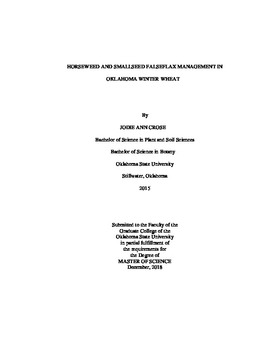| dc.contributor.advisor | Manuchehri, Misha R. | |
| dc.contributor.author | Crose, Jodie Ann | |
| dc.date.accessioned | 2019-07-19T14:08:41Z | |
| dc.date.available | 2019-07-19T14:08:41Z | |
| dc.date.issued | 2018-12-01 | |
| dc.identifier.uri | https://hdl.handle.net/11244/320951 | |
| dc.description.abstract | Quelex® (halauxifen + florasulam), Sentrallas® (thifensulfuron + fluroxypyr), and Talinor® (bromoxynil + bicyclopyrone) are three new postemergence premix herbicides developed for control of broadleaf weeds in winter wheat. These herbicides along with older products were evaluated for their control of horseweed (Conyza canadensis L.) in Oklahoma in the spring of 2017 and 2018. Control of smallseed falseflax (Camelina microcarpa Andrz. Ex DC.) also was evaluated at Lahoma, Oklahoma at the same time. Visual weed control was estimated every two weeks throughout the growing season and wheat yield was collected from three of the six site years. Horseweed size ranged from 5 to 20 cm at time of application while smallseed falseflax was approximately 6 cm both years. For the horseweed study, at all site years, halauxifen + florasulam achieved greater than 90% control with the exception of two treatments at Altus in 2018 and one at Ponca City in 2018. Thifensulfuron + fluroxypyr + dicamba achieved greater than 90% control at all site years except at Ponca City in 2017. However, when dicamba was replaced with MCPA in tank mix, control at all site years was lowered. Halauxifen + florasulam and thifensulfuron + fluroxypyr were both effective at controlling a wide range of horseweed rosette sizes across all locations while control with other treatments varied depending on presence of ALS resistance, weed size, and tank mix partners. For the smallseed falseflax study, dicamba alone achieved 90% control of smallseed falseflax while control with all other treatments was greater than 95% with the exception of halauxifen + florasulam + pyroxsulam and bromoxynil + bicyclopyrone. All treatments containing an ALS herbicide achieved adequate control of smallseed falseflax therefore resistance is not suspected in the population. For both studies, wheat yield was greater in 2017 compared to 2018 and was not affected by herbicide treatment. | |
| dc.format | application/pdf | |
| dc.language | en_US | |
| dc.rights | Copyright is held by the author who has granted the Oklahoma State University Library the non-exclusive right to share this material in its institutional repository. Contact Digital Library Services at lib-dls@okstate.edu or 405-744-9161 for the permission policy on the use, reproduction or distribution of this material. | |
| dc.title | Horseweed and Smallseed Falseflax Management in Oklahoma Winter Wheat | |
| dc.contributor.committeeMember | Baughman, Todd Alan | |
| dc.contributor.committeeMember | Arnall, Daryl Brian | |
| osu.filename | Crose_okstate_0664M_16029.pdf | |
| osu.accesstype | Open Access | |
| dc.description.department | Plant and Soil Science | |
| dc.type.genre | Thesis | |
| dc.type.material | Text | |
